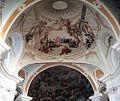Mock architecture

Pseudo architecture shows the viewer the existence of structural elements and facilities.
Illusion painting
The vanishing point perspective is often chosen in painting in order to simulate spatial depth. An example of this is the ceiling painting of the Baroque . The vault of a church opens up to the viewer standing on the ground when looking up at the sky. The edges of the opening are u. a. bordered by skillfully painted balustrades distorted in perspective . However, this illusion only works properly from a certain point, from which the central perspective unfolds its effect and illusionistically expands the space. If you leave this “ideal” point, the lines of flight change and the architecture seems to tip over. Therefore, high ceilings with a certain distance from the viewer, which naturally extends the ideal viewing position, as well as domes or vaulted ceiling approaches that support the transition from reality to illusion, are mainly suitable for this type of painting. In modern secular buildings, the decoration of ceilings with pseudo-architecture is seldom due to the lack of the required height and is mostly limited to the picturesque opening of walls (representation of the opening reveal) or the representation of a pseudo masonry.
The baroque age is also exemplary for the pseudo-architectural facade structure . Mighty columns capitals , stone layers, windows or cornices, which believes to perceive, the viewer, in this case are only of color, stucco or flat reliefs that have been placed over masonry of whole stones or bricks.
Vault fresco of the Church of Santa Maria della Carità in Brescia
Mock architecture of a fresco in Neresheim
Mock facade, mock architecture and trompe-l'oeil in New York, by Richard Haas , 1981
Villa in Brescia with a false facade
Mock architecture in the imperial court of the Munich Residence
Built pseudo-architectures
India
Already in the 3rd / 4th The Buddhist Chaitya halls of West India ( Karli , Bhaja , Aurangabad caves ), which date back to the 13th century, feature imposing false vaults and blinding architecture. In general, rock architecture as a whole can with some justification be described as pseudo-architecture (e.g. rock churches , cave temples ).
Pseudo-architecture can be found primarily in the Pallava architecture of southern India (7th – 9th centuries), in the subsequent Chola architecture (9th – 12th centuries) in terms of time and style and the architecture based on it in the Vijayanagar empire. The most important examples are the five rathas in Mamallapuram and the stepped pyramidal temple or gopuram towers in the entire southeast of the Indian subcontinent ( Kanchipuram , Thanjavur , Madurai etc.).
Europe
The artificial ruins of the 18th and 19th centuries in Europe should also be mentioned in this context.
See also
- Dazzling column
- Lüftlmalerei
- Blind window
- ornament
- Quadrature painting
- Trompe-l'oeil
- Palazzo Spada
- Santa Maria presso San Satiro






